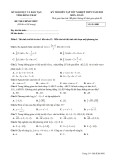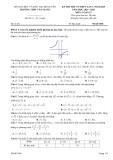
SỞ GD-ĐT QUẢNG NGÃI ĐỀ MINH HỌA TỐT NGHIỆP THPT- NĂM: 2024-2025
Trường THPT Lê Quý Đôn Môn: Tiếng Anh
Đề thi có 06 trang. Thời gian làm bài 50 phút, không kể thời gian phát đề.
Read the following article and mark the letter A, B, C or D on your answer sheet to indicate the
option that bestfits each of the numbered blanks from 1 to 6.
It is true that new technologies have had an influence on communication (1)__ people.
Technology (2)___relationships in various ways, and in my opinion there are both positive and
negative effects.
Technology has had an impact on relationships in business, education and social life. Firstly,
telephones and the Internet allow business people in different countries to interact without ever
meeting each other. Secondly, services like Skype create (3)___between students and teachers.
For example, a student can now take video lessons with a teacher in a different city or country.
Finally, many people use social networks, like Facebook, (4)__new friends and find people who
share common interests, and they (5)___ their computers rather than face to face.
On the one hand, these developments can be extremely positive. Cooperation between people in
(6)_____countries was much more difficult when communication was limited to written letters or
telegrams. Nowadays, interactions by email, phone or video are almost as good as face-to-face
meetings, and many of us benefit from these interactions, either in work or social contexts.
Question 1: A, in B. between C. with D. from
Question 2: A. affecting B. was affected C. has affected D. which affect
Question 3: A. new possibilities for relationships B. new relationships for possibilities
C. for new relationships possibilities D. relationships for new possibilities
Question 4: A. make B. made C. making D. to make
Question 5: A. do B. make C. interact D. put
Question 6: A. different B. differently C. difference D. differ
Read the following leaflet and mark the letter A, B, C or D on your answer sheet to indicate the
option that bestfits each of the numbered blanks from 7 to 12.
Improving Focus and Concentration
Want to sharpen your focus and be more productive? These strategies can help you stay on track.
Challenges: It's estimated that 60% of people (7)_____ with distractions during the day, which
affects their ability to concentrate on important tasks.
Proven Techniques:

























